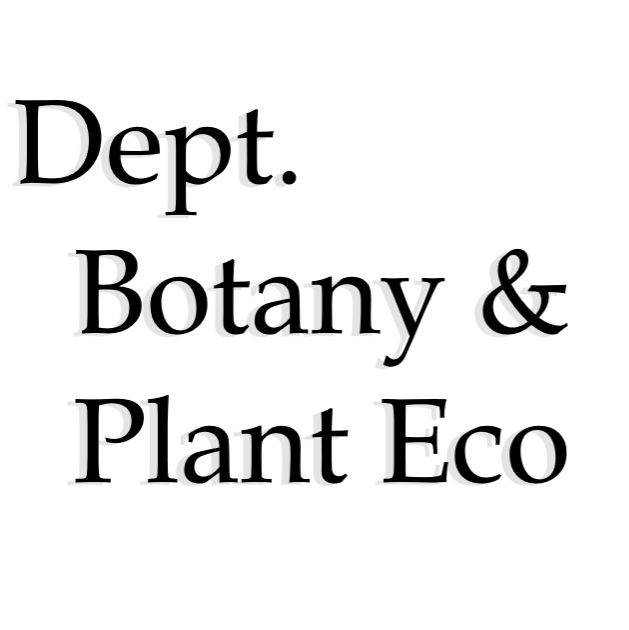The Herbarium structure
V. N. Karazin Kharkiv National University Herbarium counts more than 300.000 specimens. It is the second biggest herbarium collection in Ukraine after the National Herbarium of the NAS of Ukraine (KW).
Kharkiv University plant collection is included in a worldwide index of herbaria "Index herbariorum" (New York). It has its own acronim CWU. It keeps valuable specimens of vascular plants, mosses, fungi, and lichens. Some of the specimens are dated from the XVIII to the XX centuries.
Herbarium CWU has its own dataset in the Global Biodiversity Information Facility (GBIF) database. We actively provide inventory and digitalization of our herbarium fund for its open access for scientists in over the world.
Herbarium CWU consists of three parts.
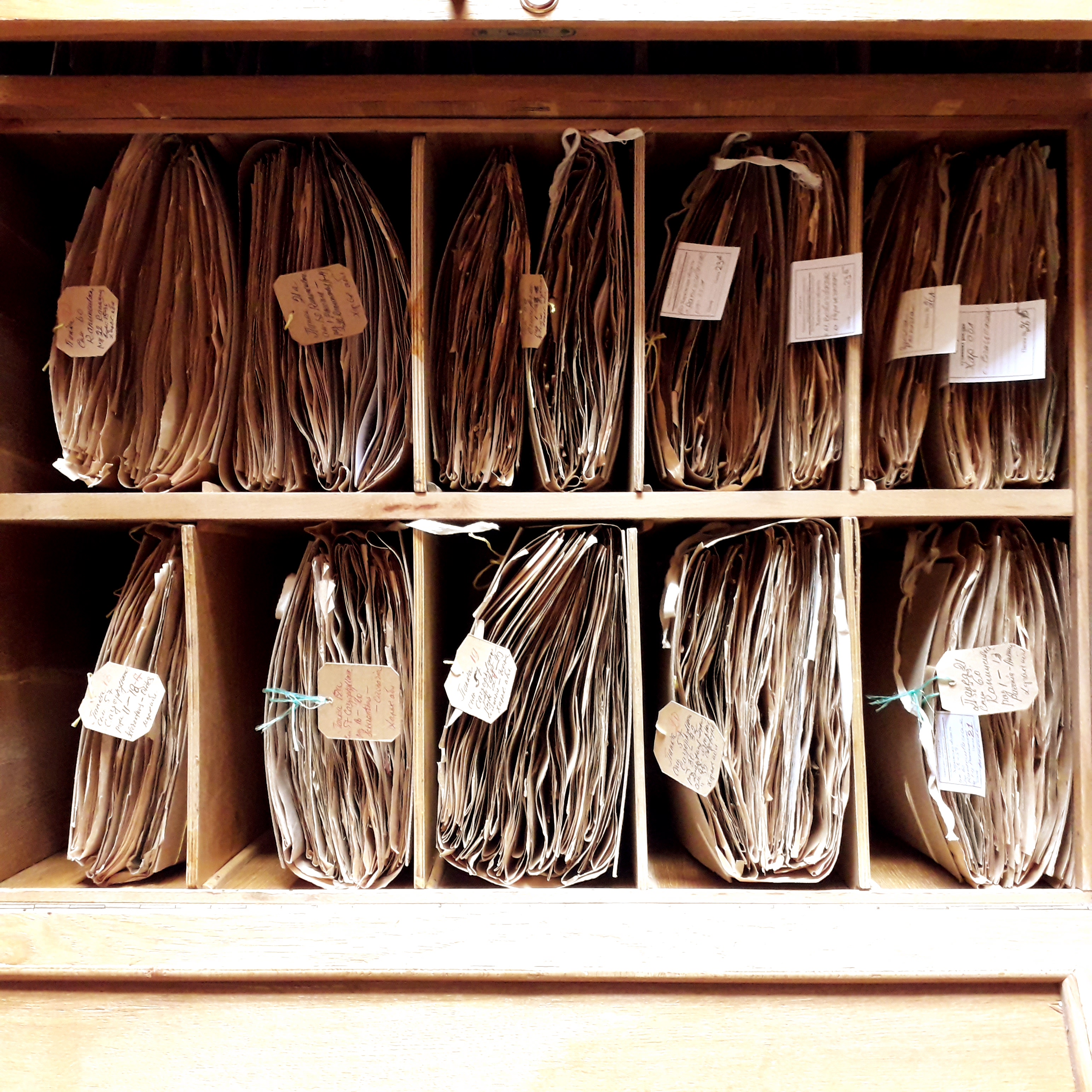
Scientific herbaria:
The Kharkiv region flora;
The Ukrainian flora;
The Crimean flora;
The Eurasian flora;
The Herbaria of the grasses of Ukraine and adjacent territories;
Exsiccata and herbaria of mosses, fungi, and algae of Europe, Eurasia, and Ukraine;
The lichenicolous herbaria.
Demonstrative and study herbaria:
Botanical Geography (the different nature zones flora of the Earth);
Culture plants (Культурні рослини (varieties and species of wild and cultivated plants);
Botany: Thallobionta;
Botany: Cormobionta;
Medicinal Plants;
Dendrology;
Rare and threatened plants;
Local flora.
Algotheca:
Scientific and study collections of alive cultures and fixed algae preparations.
Herbarium history and the valuable collections
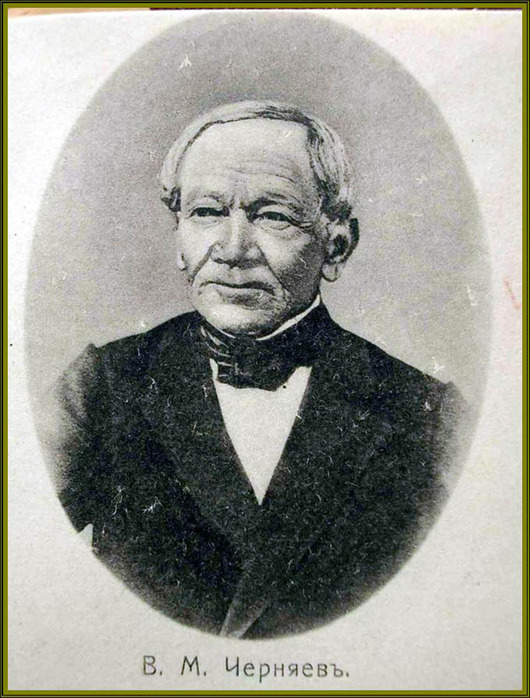
Vasiliy M. Chernjajev
(1793 - 1871)
The First Department's head Francois de la Vigne brought the first herbarium samples (approximately 600 h.s.) and other demonstrative materials in 1805. But the official date of the Herbarium creation is 1825 when the next Department's head Vasiliy Chernjajev gave away his own collection to University. He has been collecting herbaria for 13 years. This event was the start of almost 200 years of history of the Kharkiv University Herbarium. His collection counts more than 37 thousand specimens. This collection represents the flora of Ukraine, Asia, France, Italy, and Switzerland. V. Cherjajev's herbarium includes specimens collected not only for himself but also gotten as exchanged with other well-known collectors of those times. In 1943, when Kharkiv was occupied by Germany, V. Chernjajev's and other valuable collections were taken out to Germany. This collection turned back to Ukraine but most of the samples stayed in Kyiv and became the part of National Herbarium of Ukraine (KW). Today, Kharkiv University Herbarium keeps approximately 200 herbarium sheets from V. Chernjajev's collection.
In 1848, a well-known botanist and systematic Nikolai Turchaninov handed over his collection at Kharkiv University. It was one of the most significant events in CWU Herbarium history. There were the samples he collected by himself, exchanged, and bought from other gatherings. Famous botanists and collectors of those times (A. de Candolle, J. Bentham, C. von Ledebour, P. Boissier, and others) also donated specimens to M. Turchaninov. A significant part of M. Turchaninov's herbarium collection became the specimens gathered by S. Shchegleev (1820–1858), who worked at Kharkiv University. There are typical specimens among Turchaninov's herbarium. Mykola Turchaninov used some of the collected by himself samples to describe numerous new species and a few tens of new genera.
M. Turchaninov's herbarium stayed in Kharkiv until 1943. German army deposited collections in Germany during the Kharkiv occupation in World War II. Almost a whole gathering turned back to Ukraine after the War. But it and Chernjajev's herbarium collections stayed in Kyiv. They became a significant part of the National Herbarium of Ukraine. Approximately 100 specimens of Mykola Turchaninov's store in V. N. Karazin Kharkiv National University these days.

Nikolai S. Turchaninov
(1796 - 1863)
At the beginning of the XX century, Kharkiv National University was a floristic and systematic research center in Ukraine. V. Artsymovych, as a herbarium keeper, made a significant arrangement work. He held this position since 1908. Besides, Valerii Taliev (1872–1932) made a valuable contribution to Herbarium forming. He has been working at the university for almost 20 years. He deposed his gatherings in Kharkiv University Herbarium (CWU) and Nikita Botanical Garden Herbarium (JALT). There are future well-known botanists such as Ye. Lavrenko (was herbarium keeper), M. Kotov, M. Klokov, I. Zoz, M. Shalyt, I. Artemczuk, D. Sakalo, F. Levina, N. Kostenko, A. Alekseev, M. Alekseenko, D. Vilenskyi, V. Zaleskyi, Yu. Kleopov, P. Kozlov, N. Kuksin, I. Litvinenko, H. Nakonechna, P. Opperman, O. Pryanishnikov, M. Ryzhutin, N. Osadcha (Yanata) and others worked in Kharkiv University. The specimens collected by these scientists significantly replenished Herbarium CWU.
There were K. Hornutskyi, P. Nalyvaiko, A. Naumov, B, Kaminski, K. Zaleski, M. Savenkov, K. Uhrytskyi, S. Piskunov, and others, among the most famous Kharkiv regional flora researchers filled the Herbarium.
Yurui D. Kleopov has been leading the Department of Botanical Geography for eight years (1934–1941). The Herbarium became bigger during Yu. Kleopov's supervising. Yu. Kleopov collected plants during his numerous expeditions in Ukraine and Asia.
Thus, Kharkiv University had a considerable and unique herbarium collection before WWII. The War beginning, evacuation, and occupation of Kharkiv city led to herbarium fund loss. The data about some well-known gatherings is still unknown. Some collections were replaced in the Botanical Museum of Berlin, and others - were most likely lost forever. In 1943, German troops took out Kharkiv University's Herbarium and other the most valuable Ukrainian culture and historical properties in Germany. Fortunately, they were turned back in Ukraine. These collections of Kharkiv University stayed in Kyiv. They were united with other unique gatherings of the modern Institute of Botany of NAS of Ukraine. Nowadays, most world-historical valuable collections are a part of the National Herbarium of the Institute of Botany (KW).
The modern Herbarium CWU is represented by gatherings collected after WWII. The significant role of the herbarium replenishing made lecturers, scientists, and students of the Department. Herbarium CWU is composed of three parts: Scientific, Demonstrative herbaria, and Algal Theca. Each part consists of several sections. The Scientific part consists of Vascular Plants herbarium (Flora of Ukraine, Flora of Eurasia, Flora of the Crimea Penninsula, Flora of The Kharkiv Region, Yu. M. Prokudin Herbarium of Cereals of Ukraine and Adjected Territories), Herbarium of The Macrophyte Alges, Licheniculous Herbarium, and Bryophytes Herbarium. Also, V. N. Karazin Kharkiv National University's Herbarium has Exciccata of Algaes, Mosses, Fungi, and Lichens.

Mykhailo V. Klokov
(1896–1981)
The modern herbarium of Vascular Plants (more than 260.000 specimens) predominantly contains the samples collected after WWII. The students' practices, botanical excursions, and expeditions through Ukraine and the world played a significant role in herbarium fund multiplication. The unique collections, typical materials, and outstanding botanists' gatherings became a part of CWU. Among them, M. Klokov and I. Zoz's collections should be noted because these gatherings contain several authentical specimens.
The list of authentic materials is refreshing continuously during the fund inventory works. Some of them we find in other collections.
Some collectors worked after WWII, and their gatherings have significant value, e.g., M. Tzvelev, Yu. Prokudin, M. Alekseenko, A. Konstantinova, V. Tsygankova, K. Ermolemko. More modern collectors who filled the CWU fund with new specimens are V. Tveretinova, L. Gorelova, G. Chernaya, N. Saidakhmedova, O. Bezrodnova, Yu. Gamulya, and others.
Some regional collections keep separately. Among them, is Herbaria of the West Siberia Flora from P.N. Krylov Herbarium of Tomsk State University. Perhaps, Kharkiv University got it before WWII. The total number of samples is approximately 150 herbaria sheets, and this number is growing during the inventory work in other collections. The most valuable among them are 18 specimens collected by P. Krylov on his own. His collection illustrates Siberian flora (Altai, Semipalatinsk and Yenisei provinces, Ust'-Kamenogorsk, Minusinsk), and it is dated 1890–1931. There are L. Sergievskaya (Chitin region, East Siberia, Tomsk, Transbaikal, 1925–1936), B. Shishkin (Altai, Semirechensk region, Tomsk, Uriankhaiska Land, 1908–1927), V. Sapozhnikov (Altai, 1890–1931), Z. Torchevska and S. Gluzdamov (Khakasia, 1931–1935), V. Reverdatto (West Sayany, 1923–1931), M. Albitskaya (1884–1931), and others among collectors whos gathering detected in this collection.
In addition to regional herbaria showing Eurasian flora, Kharkiv University's Herbarium contains systematic gatherings. Among them, the most famous and richest collection is the Cereals Herbarium of Ukraine and adjacent territories formed by Yuriy. M. Prokudin supervising. This collection is the biggest cereals collection in Ukraine.
In 1930s, professor Yu. Prokudin and other employees started to collect cereals herbaria in Ukraine and neighboring countries. This gathering is a result of a few generations' work. This unique collection counts more than 20.000 herbarium specimens of the core fund, and a significant unhandled fund needs to be processed. Herbaria represents 98 genera placed by a system accepted in the monograph "Cereals of Ukraine" (1977). Species samples collected in different localities are placed separately by the subsections: Right-Bank Ukraine, Left-Bank Ukraine (without the Kharkiv region), the Kharkiv region, the Crimea peninsula, and herbaria collected outside Ukraine (52 species).
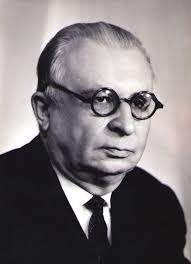
Yuriy. M. Prokudin
(1911 – 1992)
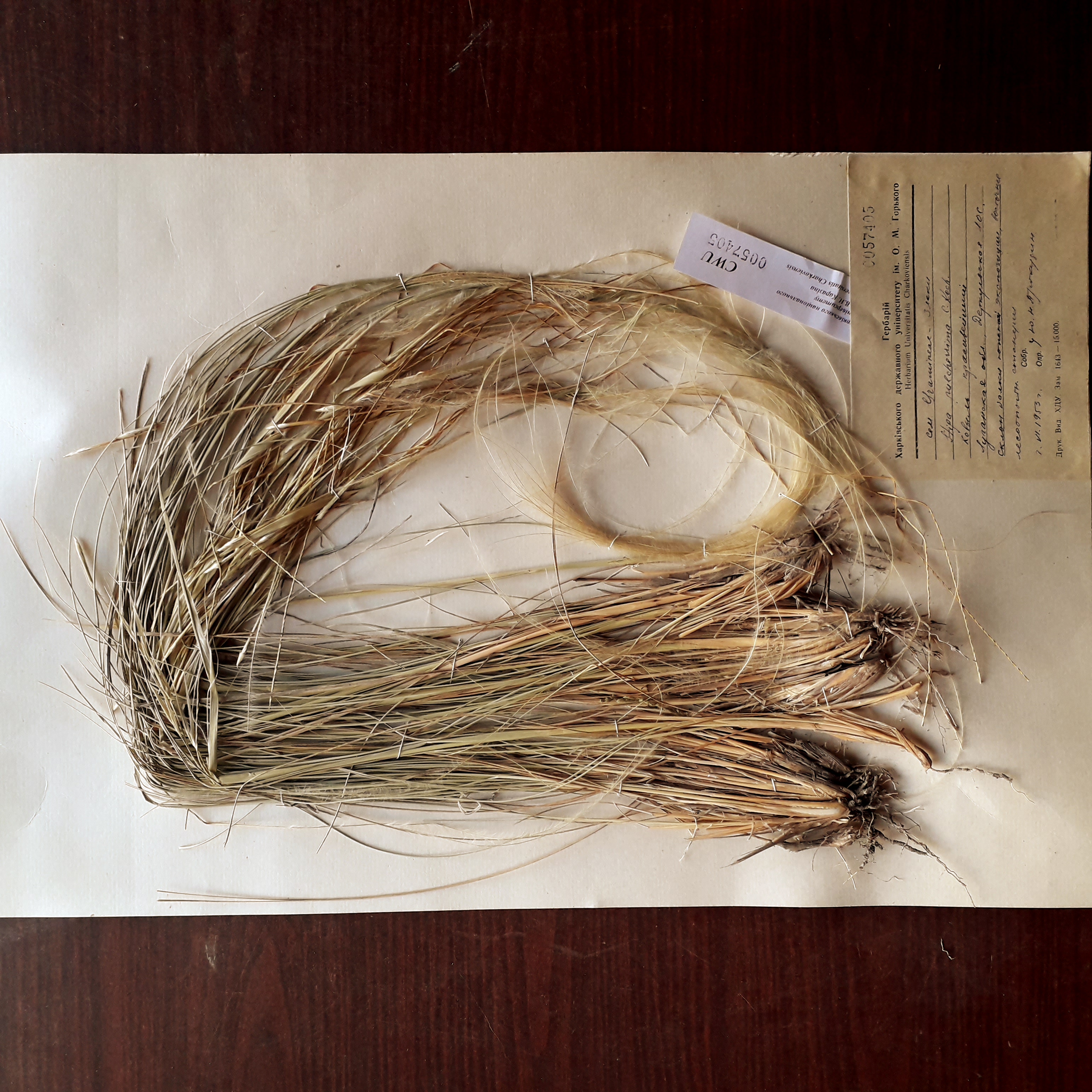
Stipa pulcherima C. Koch. specimen,
collected by Yu. Prokudin
The Triticum (Agropyrum) collection is separately located in the Cereals Herbarium. This small collection contains unique specimens dated XIX century and collected in North America (North Dacota), and Europe (Hungaria, Austria). The historical value of this collection is samples collected by V. Chernjajev and by the first Department head – F. de la Vigne. The Stipa pulcherima C. Koch. and Stipa dasyphylla (Czern. ex Lindem.) Trautv. specimens collected by V. Chernjajev are in the Cereals Herbarium of Ukraine. Also, it contains N. Turchaninov's samples. We constantly find them during this collection handling. According to preliminary data, the number of such specimens could be a few hundred.
The Department collaborated with numerous institutions and scientists during the Cereals Herbarium processing. These events significantly filled the Herbaria fund. Donetsk Botanical Garden gave the collection of the Stipa sp. genera (14 species). In 1960, Professor of Kuban University R. Seredin sent gatherings collected in the Kozache-Lager arena (specimens of 20 species from 12 genera). Eight species represent the Exciccata of the Cechoslovanic Republic's flora (Flora exiccata Respublicae Cechoslovanicae, Brno, 1948-1949). Herbaria of Latvia, Far East, Transcarpathian's cereals, and cereals of Kamiani Mohyly, Askania-Nova, and Aksu-Dzhabagly (Middle Asia) Reserves layout separately.
The core herbarium funds are collected and handled by the lecturers and scientific staff of the Department. Professor Yu. Prokudin made the most significant contribution to collecting and filling the Cereals Herbarium. Besides, some scientists have considerable value for gathering and analyzing some parts of this collection. For instance, M. Alekseenko (gatherings from different Ukrainian regions, 1933–1960), M. Bashynska (specimens of 1935–1938), Yu. Vernichenko (cereals of Carpathians). O. Pojarkova and M. Kalenichenko analyzed Poa L. genera; O. Vovk processed Festuca L.; L. Slusarenko – Bromus L.; I. Druliova –Elytrigia Desv. All of them were active participants in scientific expeditions. Each of them contributed their share to the scientific herbarium of cereals at Kharkiv University creation.
One of the most represented genera in this collection is the herbarium of Festuca genera. It contains almost 2.000 specimens of the core fund and several hundreds of unhandled samples. Now, CWU herbaria contain samples of 39 genera. Thirty genera demonstrate the Ukrainian flora, and nine genus represent the flora of other countries. Most folders contain 10–20 specimens. There are unique gatherings among them, e.g., Festuca tianschanica Roshev. collected by S. Korzhynskiy in Turkestan (1895); Festuca drymeja Mert. & W.D.J. Koch collected by Kervic (1896); Festuca gigantea (L.) Vill. gathered by V. Markovich (1897). Most Festuca specimens are dated 1957–1980. But the most valuable samples are herbaria of the middle of XIX – the beginning of the XX centuries. There are V. Chernjajev's and L. Kolokolnikov's herbaria, including a few typical specimens among them.
According to our data, the Cereals Herbaria of Ukraine and Adjacent Territories counts specimens gathered by approximately 200 collectors. Yu. Prokudin, E. Ermolenko, L. Slusarenko, Yu. Vernichenko, A. Konstantinova, V. Tveretinova, and N. Tzvelev are the most considerable contributors to this collection.

Ludwig Rabenhorst
(1806–1881)
The modern algological herbarium CWU has approximately 5.000 specimens and contains several separate collections. Dr. Gottlob Ludwig Rabenhorst's European Algae Exciccata (Dr. L. Rabenhorst: «Die Algen Sachsens» «Die Algen Europas») is a historical part of algal herbaria. We stored the marine algae herbaria separately: Chlorophyta, Rhodophyta, and Phaeophyta of Barents Sea (collector: I. Dosicheva), Japan Sea (collectors: G. Bardunova, L. Matiusha), and Black Sea (total specimens number is +500).
The Algal Theca is a valuable part of CWU Herbarium. This part demonstrates the algal flora of fresh water. There are samples collected in Baikal Lake (Barguzin Reserve; collector: A. Gromakova), "Dunaiski Plavni" Reserve (collector: K. Shikhzadaeva), Siverkyi Donets river (collector: O. Gorbulin), "Nyzhniovorsklianskyi" Regional Nature Park (O. Raida).
The freshwater algae collection includes more than 1.500 samples. We use them for classes predominantly. Each bottle contains mass material of a single species (less often – two) without the collector's name and gathering place indication. We fill this collection constantly during the expeditions through Ukraine and adjacent territories.
The mycological herbarium contains approximately 10.000. It is represented by an almost comprehensive exsiccata collection and separate herbaria collection. The most famous of them are «Fungi Europaei exsiccati» (L. Rabenhorst; several eddition), «Fungi selecti exsiccati» (O. Jaap), «Chytridineae» (О. Trebaux), «Fungi Rossici exsiccati» (F. Buchgoltz), and others. These collections contain a lot of valuable specimens and authentic materials. It needs to be thoroughly researched. The historical part of the mycological herbarium is only stored in our Department, the core fungal collection is in the Department of Mycology and Plant Resistance. More information about the mycological section of herbaria you can find here.
We use demonstrative fungi collection for classes. Our staff constantly replenish these training gatherings due to expeditions through the Kharkiv region.
The lichenicolous herbarium (more than 10.000 specimens) also contains historical value collections such as «Lichenes Helvetici Exsiccati» (L. Schaerer), «Lichenes Europaei Exsiccati» (L. Rabenhorst), «Lichenotheca Rossica Regionibus Confinibus Complecta» (V. P. Savicz), and unique collection «Lichenum Selecti Germaniae» (G. Körber). The last gathering counts 93 specimens from 65 genera.
The lichenicolous herbaria are divided by gatherings region or by systematics. Parmeliaceae family only counts more than 180 specimens (16 genera, 35 species) collected from 1906–2018. Some of them have particular value: Parmelia hyperopta Ach. collected by A. Elenkin in 1906; specimens collected by V. Savich in the expeditions to the Kamchatka Peninsula (1908 and 1909); and others.
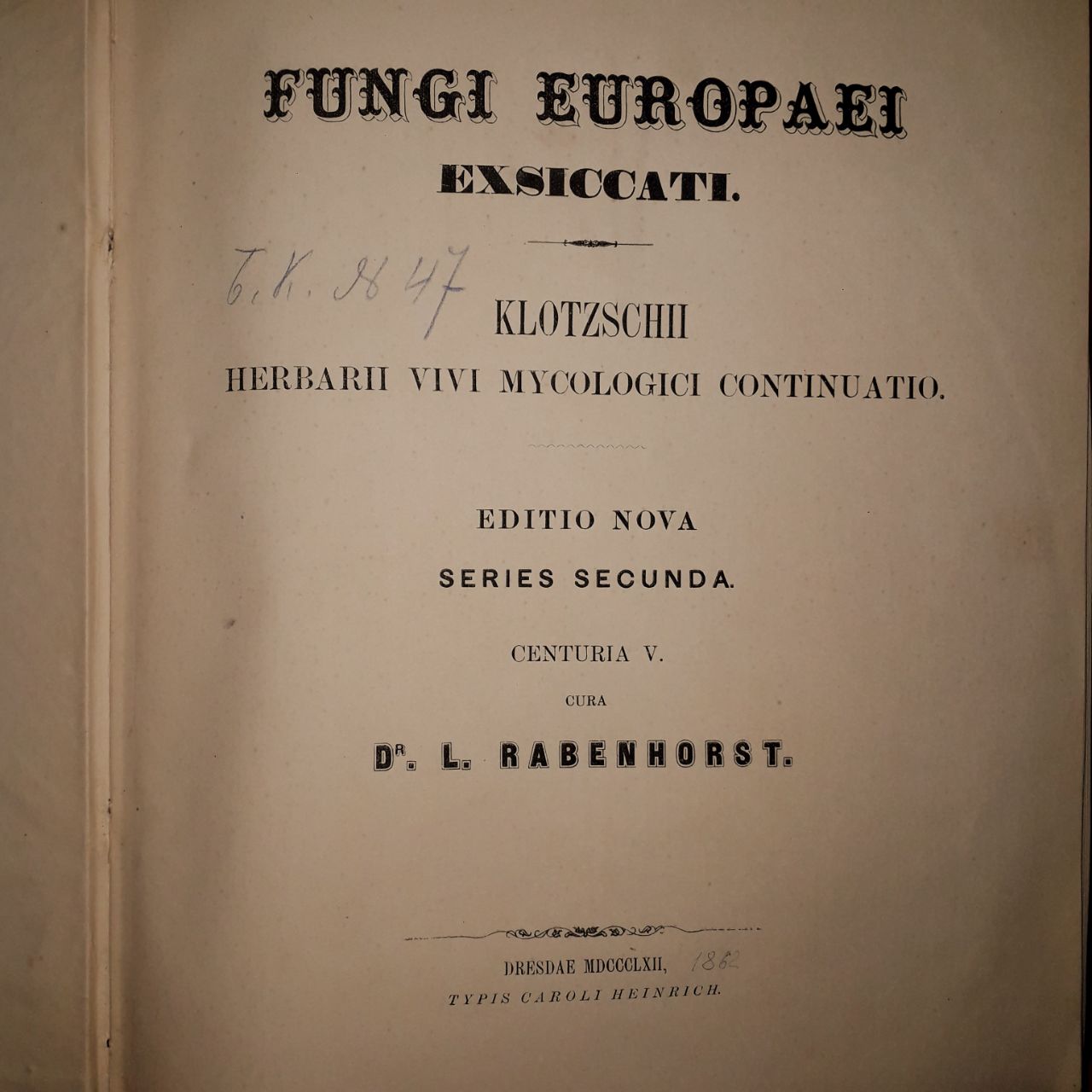
"Fungi Europaei exsiccati"
L. Rabenhorst, 1862
After WWII, the scientists of the Department actively filled the lichenicolous collections from different places in Eurasia. In particular, N. Ilchenko, R. Zhupanenko, K. Ermolenko, T. Dagadina brought specimens from the Kolsky Peninsula; T. Dogadina and N. Romanchuk - from Yakutia; T. Dogadina - from the Caucasus; T. Dagadina and K. Kuzmenko - from Transbaikal. Over the last few years, A. Gromakova replenishes this section of herbaria by gatherings from different parts of Ukraine (the cretaceous outcrops; Carpathians; rock outcrops in the Steppe zone, other Nature Reserve Fund objects, etc.).
The bryological section contains several historical collections and modern gatherings (a total is 10.000 specimens). The most valuable collection is Marchantiophyta and Antocerotophyta of Europe ("Hepaticae Europaeae" Dr. Gottasche und dr. L. Rabenhorst. Dresden, 1871). This collection counts 569 herbarium sheets representing 183 species and 55 genera. In general, the gathering has been preserved quite well and in its entirety.
Texted by: Yu. Gamulya, T. Dogadina, H. Bondarenko
The research made with Herbarium CWU using
Жежера, М.Д., Громакова, А.Б. (2021). Навчальна колекція фіксованих проб водоростей у Гербарії (CWU) Харківського національного університету імені В.Н. Каразіна. Гербарії ХХІ століття: Досягнення та виклики. Матеріали Міжнародної наукової конференції, присвяченої 100-річчю від заснування Національного гербарію України (KW) – Гербарію Інституту ботаніки імені М.Г. Холодного НАН України (1 жовтня 2021 року, Київ). Київ: Інститут ботаніки ім. М.Г. Холодного НАН України, 45–49.
Звягінцева, К.О., Моунассир В.В. (2021). Зразки видів адвентивних рослин у Гербарії Харківського національного університету імені В.Н. Каразіна (CWU). Гербарії ХХІ століття: Досягнення та виклики. Матеріали Міжнародної наукової конференції, присвяченої 100-річчю від заснування Національного гербарію України (KW) – Гербарію Інституту ботаніки імені М.Г. Холодного НАН України (1 жовтня 2021 року, Київ). Київ: Інститут ботаніки ім. М.Г. Холодного НАН України, 51–55.
Казарінова, Г.О. (2021). Рід Stipa L. в Гербарії Харківського національного університету імені В.Н. Каразіна. Гербарії ХХІ століття: Досягнення та виклики. Матеріали Міжнародної наукової конференції, присвяченої 100-річчю від заснування Національного гербарію України (KW) – Гербарію Інституту ботаніки імені М.Г. Холодного НАН України (1 жовтня 2021 року, Київ). Київ: Інститут ботаніки ім. М.Г. Холодного НАН України, 55–60.
Комариста, В.П. (2021). Колекція живих культур мікроводоростей у Гербарії Харківського національного університету імені В.Н. Каразіна (CWU). Гербарії ХХІ століття: Досягнення та виклики. Матеріали Міжнародної наукової конференції, присвяченої 100-річчю від заснування Національного гербарію України (KW) – Гербарію Інституту ботаніки імені М.Г. Холодного НАН України (1 жовтня 2021 року, Київ). Київ: Інститут ботаніки ім. М.Г. Холодного НАН України, 64–68.
Gamulya, Yu., Bondarenko, H., Zhelnierovich, O. (2021). The Ranunculaceae family representatives included in the Red Data Book of Ukraine in V. N. Karazin Kharkiv National University herbarium (CWU). Гербарії ХХІ століття: Досягнення та виклики. Матеріали Міжнародної наукової конференції, присвяченої 100-річчю від заснування Національного гербарію України (KW) – Гербарію Інституту ботаніки імені М.Г. Холодного НАН України (1 жовтня 2021 року, Київ). Київ: Інститут ботаніки ім. М.Г. Холодного НАН України, 163–166.
Nachychko, V.O., Gamulya, Yu.G., Sosnovsky, Ye.V. (2019). Typification of four names in Thymus (Lamiaceae) based on material from the Herbarium of V.N. Karazin Kharkiv National University (CWU). Phytotaxa, 409 (2), 71–82.
Начичко, В.О., Гамуля, Ю.Г. (2019). Типові зразки роду Thymus L. (Lamiaceae) в гербарії Харківського національного університету імені В.Н. Каразіна (CWU). Біологічні Студії, 13(1), 145–160.
Гамуля, Ю., Сіра, О., Бондаренко, Г. (2018). Колекція бріофітів О. В. Галаніна в гербарії Харківського національного університету імені В. Н. Каразіна (CWU). Вісник Львівського університету. Серія біологічна, 78, 184–188.
Antonenko, S. I., Shyian, N. M. (2018). Typification of the names of taxa of Polygonum (Polygonaceae) described from Ukraine. Ukrainian Botanical Journal, 75(2), 109–122.
Гамуля, Ю.Г. (2016). Аутентичні матеріали роду Tragopogon (Asteraceae) у гербарії Харківського національного університету імені В.Н. Каразіна (CWU). Український ботанічний журнал, 73(4), 404–408.
Contacts
Curator of Herbarium CWU:
Dr. Yurii G. Gamulya, PhD, Associate professor.
e-mail: y.gamulya @karazin.ua
Address: 61022, V. N. Karazin Kharkiv National University, Ukraine, Kharkiv, Maidan Svobody, 4, room 5-16.
Curator of Lichenicolous Herbarium CWU:
Dr. Alla B. Gromakova, PhD, Associate professor.
e-mail: y.gamulya @karazin.ua
Address: 61022, V. N. Karazin Kharkiv National University, Ukraine, Kharkiv, Maidan Svobody, 4, room 5-17.
